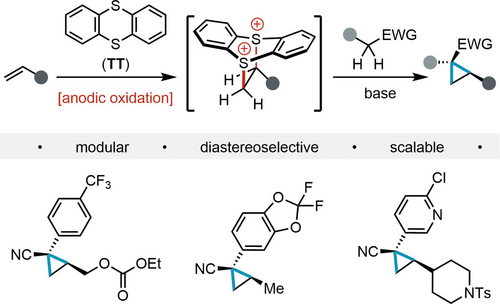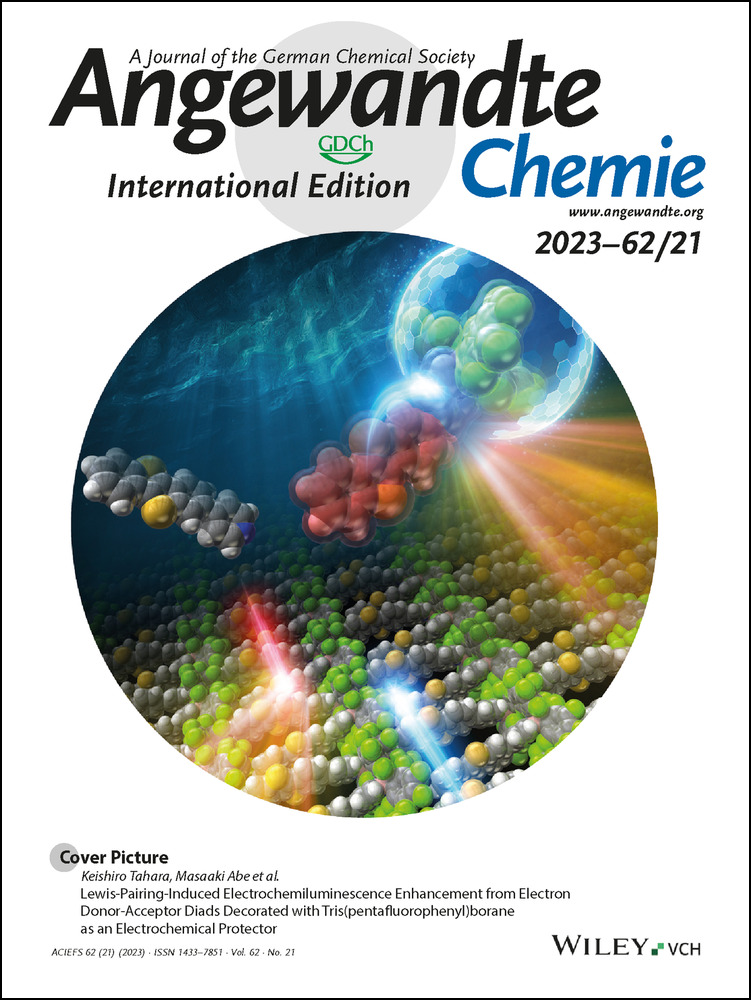Diastereoselective Synthesis of Cyclopropanes from Carbon Pronucleophiles and Alkenes
Graphical Abstract
Abstract
Cyclopropanes are desirable structural motifs with valuable applications in drug discovery and beyond. Established alkene cyclopropanation methods give rise to cyclopropanes with a limited array of substituents, are difficult to scale, or both. Herein, we disclose a new cyclopropane synthesis through the formal coupling of abundant carbon pronucleophiles and unactivated alkenes. This strategy exploits dicationic adducts derived from electrolysis of thianthrene in the presence of alkene substrates. We find that these dielectrophiles undergo cyclopropanation with methylene pronucleophiles via alkenyl thianthrenium intermediates. This protocol is scalable, proceeds with high diastereoselectivity, and tolerates diverse functional groups on both the alkene and pronucleophile coupling partners. To validate the utility of this new procedure, we prepared an array of substituted analogs of an established cyclopropane that is en route to multiple pharmaceuticals.
Cyclopropanes are important structural motifs with diverse applications as synthetic intermediates, mechanistic probes, and design elements of bioactive molecules.1-10 In the context of medicinal chemistry, these three-membered carbocyclic rings are employed to increase potency, reduce off-target effects, and fine-tune metabolic stability.10-12 Recognition of these strategic benefits has driven the number of approved small molecule drugs containing cyclopropanes to double over the last ten years.13 Recently, other structurally rigid ring systems are emerging as an appealing design strategy to precisely control the 3D molecular geometry of drug candidates.11, 14-20 While in principle cyclopropanes offer a myriad of 3D shapes, 64 % of the cyclopropane rings in active pharmaceutical ingredients are substituted at only a single carbon (Figure 1, top).13, 21 This overrepresentation of a narrow subset of possible substitution patterns is, in part, due to the reactions used to construct cyclopropane rings. For example, cyclopropanes substituted at one carbon are straightforward to access on large scale via enolate alkylation using 1,2-dihaloethane dielectrophiles. However, vicinal dihalides bearing any additional substituents suffer inextricable elimination reactions, limiting access to more substituted analogs through this intermolecular disconnection.22-25 The Corey–Chaykovsky reaction offers an alternative method that allows synthesis of more substituted cyclopropanes but requires activated electron-deficient π-systems (e.g. α,β-unsaturated carbonyl compounds).26-29 The most well-studied approach to prepare more substituted cyclopropanes from a broader range of alkenes remains cyclopropanation based on metal carbenoid reactivity (Figure 1, middle).30-40 While indisputably effective, the modularity of these methods is limited by the requisite synthesis of unique carbene precursors to deliver each distinct substituent. Furthermore, hazardous diazo compounds are commonly required, which further complicates broad implementation due to safety concerns.41-57 Despite these varied approaches to prepare cyclopropanes, development of new approaches is an area of contemporary interest.58-63 Overall, a modular annulative cyclopropane synthesis that couples two abundant building blocks has remained elusive and is poised to substantially impact synthetic chemistry.
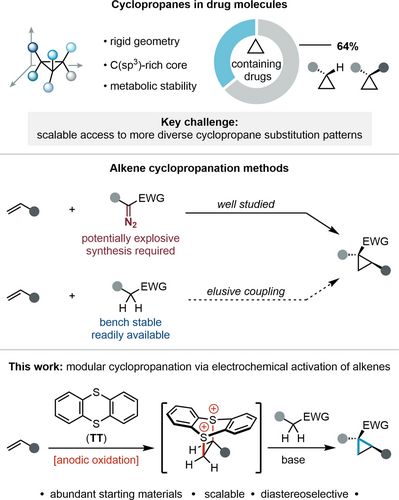
Project overview. Cyclopropanes in drug molecules (top); alkene cyclopropanation methods (middle); overview of this work (bottom).
A deceptively straightforward strategy to access cyclopropanes in a modular fashion would be through the direct intermolecular oxidative coupling of carbon pronucleophiles and alkenes. Unfortunately, this idealized reaction has remained elusive.64-66 In principle, the net transformation could be accomplished through conversion of an alkene to a dielectrophile that undergoes iterative substitution with a methylene pronucleophile rather than deleterious elimination. No established dielectrophile possesses the requisite selectivity profile to accomplish this in a general fashion.
Recent work has begun to explore the diverse and unique electrophilic reactivity of thianthrenium salts.67-76 Our group recently developed an electrochemical strategy to generate dicationic adducts between unactivated alkenes and thianthrene (TT) that serve as dielectrophiles.67, 68, 77-79, 72 Specifically, we found these species underwent substitution by primary amine nucleophiles without deleterious elimination, unlocking a new approach to prepare N-alkyl aziridine products.80-82 Very recently, Shu and co-workers reported a related method of preparing aziridines through the reaction of isolated alkenyl thianthrenium salt with nitrogen nucleophiles.83 Additionally, this study extended the alkenyl sulfonium reactivity to cyclopropane synthesis from a handful of malonates and similarly acidic carbon pronucleophiles. Concurrently, we were exploring the use of alkene-derived thianthrenium salts to enable a new approach to cyclopropanation. In contrast to Shu's studies, however, our investigations explored the strategic advantages offered by such an approach in the synthesis of heteroaryl-substituted cyclopropanes as well as the reaction diastereoselectivity. Herein, we report the results of these investigations into the reactivity of dicationic thianthrene-alkene adducts with carbon pronucleophiles (Figure 1, bottom). This led to a modular and diastereoselective approach to prepare heteroaryl-substituted cyclopropanes from abundant precursors as well as key insights into the dicationic adduct substitution mechanism that transcend cyclopropanation processes.
We initiated our investigations using nitrile pronucleophile 3. This model pronucleophile was selected for two primary reasons: (1) we suspected that sterically differentiated carbanion stabilizing groups would maximize diastereoselectivity, and (2) basic nitrogen heterocycles are pervasive in medicinal chemistry but their coordinating ability can challenge many established alkene cyclopropanation procedures.84-86 After initial optimization of reaction conditions (see Supporting Information for details), we found this pronucleophile underwent base-promoted cyclopropanation with dicationic adducts (1 and 2) in high yield (Scheme 1, top). Consistent with our hypothesis, small nitrile substituent promotes high diastereoselectivity (≥20 : 1 d.r.). Indeed, conducting the same procedure with an analog of 3, wherein the nitrile is replaced with an ester, furnished the product in diminished diastereoselectivity (2 : 1 d.r., see Supporting Information for details). Although these initial conditions were effective, they required a substantial excess of Cs2CO3 base (10 equiv.) to favor the desired cyclopropane over the elimination product, an alkenyl thianthrenium salt (5). Given that initially we anticipated increased formation of elimination byproducts upon increasing base equivalents, we suspected that a more complex mechanistic pathway might be occurring rather than simple iterative substitution.
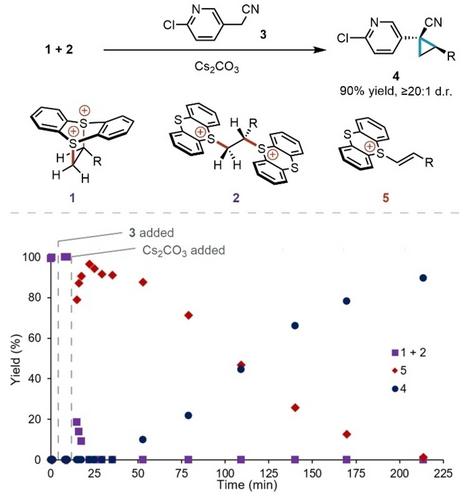
Initial experiments investigating cyclopropanation.[a] [a] Top reaction was conducted using alkene (0.15 mmol), TT (0.225 mmol), 3 mL of MeCN-d3 (0.2 M KPF6); then pronucleophile (0.15 mmol), Cs2CO3 (1.5 mmol), 2.5 h. Yields and d.r. are 1H NMR analysis. See the Supporting Information for further details. R=CH2CH2Ph.
To investigate the mechanism of cyclopropanation, we monitored the substitution of dicationic adducts by 1H NMR (Scheme 1, bottom). Intriguingly, the dicationic adducts are rapidly consumed to form alkenyl thianthrenium salt 5. This elimination product is subsequently converted to cyclopropane product 4. Overall, this time course analysis suggests that an alkenyl thianthrenium 5 is a key intermediate en route to cyclopropanation. This proposal is consistent with prior work on vinyl sulfonium salts, which undergo cyclopropanation reactions with malonates and related pronucleophiles. However, these previously reported transformations have been predominantly limited to unsubstituted vinyl sulfonium salts.87-94 Only a handful of alkenyl sulfonium salts have been found to undergo cyclopropanation.94-100 Given the relatively limited examples of cyclopropanation from unactivated alkenyl sulfonium salts similar to 5, we validated this potential mechanism by isolating 5 and resubjecting it to the substitution conditions. This experiment afforded the cyclopropane product 4 in 89 % yield, validating the kinetic competency of this species as an intermediate in cyclopropanation. This electrophilic elimination product also offers a plausible explanation for the distinct reactivity profile of the dicationic adducts relative to conventional dihalide dielectrophiles, since alkenyl halides do not undergo addition with nucleophiles. With this mechanism in mind, we streamlined access to the key alkenyl thianthrenium intermediate by passing the dicationic adduct solution through a short pad of basic alumina prior to addition of the pronucleophile and base. This modified procedure furnished the desired cyclopropane product 4 in 81 % yield relative to alkene as a single diastereomer using one equivalent of pronucleophile and two equivalents of Cs2CO3.
With an optimized procedure in hand, we next examined the scope of this new cyclopropanation protocol. We found that this process enabled the formal coupling of a wide range of carbon pronucleophiles and unactivated alkenes (Table 1). First, we probed a range of nitrile pronucleophiles substituted with a second strong electron withdrawing group. Alkylnitriles bearing amide (6, 7), ester (8), sulfone (9), benzophenone imine (10), and phosphonate (11) α-substituents each underwent efficient cyclopropanation. High diastereoselectivity was observed across the majority of these substrates and the relative configuration was unambiguously verified by X-ray crystallography in several cases.101 These stereochemically defined cyclopropane building blocks each bear distinct synthetic handles for further diversification. Furthermore, acidic cyclic pronucleophiles were converted into a range of architecturally complex spirocyclic building blocks (12–14) from simple precursors. Symmetrical pronucleophiles such as malonate and malononitrile were also suitable coupling partners and afforded the expected cyclopropane products (15, 16). We next explored the scope of this methodology with respect to less acidic pronucleophiles bearing diverse and medicinally-relevant (hetero)arenes as secondary withdrawing groups. We found that alkylnitrile pronucleophiles substituted with pyridines (17, 18), pyrimidines (19), thiophenes (20), thiazoles (21), and trifluorotoluene derivatives (22) each underwent efficient and diastereoselective cyclopropanation. Of note, established carbene-transfer-based approaches to related products deliver the opposite relative stereochemistry.85 Hetereoarene substituted pronucleophiles with an ester instead of a nitrile furnished the final cyclopropane product in high yield, albeit with diminished diastereoselectivity (23). We also found that nitromethane, an inexpensive commodity chemical, could be employed to prepare 1,2-disubstituted cyclopropane (24) with high selectivity for the trans product. Less acidic pronucleophiles bearing a weaker single electron withdrawing group failed to deliver more than trace amounts of cyclopropane products (see Supporting Information for details). Throughout these studies, we found that variation of the alkene coupling partner provided access to cyclopropane building blocks bearing diverse pendant functional groups, such as acetates (12), carbonates (22), nitriles (14), phthalimides (6, 13), and sulfonamides (8). Additionally, steric hindrance about the alkene was well tolerated (10, 14, 16, 18, 20). Notably, unconjugated dienes (7, 9) and ene-ynes (21) both underwent selective cyclopropanation at a single site, leaving a pendant unsaturated π-system for subsequent derivatization. An alkene substrate containing an α,β-unsaturated ester (17, 24) underwent selective cyclopropanation at the more electron-rich alkene. This demonstrates high selectivity both in the generation of the key electrophilic alkenyl thianthrenium intermediate as well as for cyclopropanation over enolate 1,4-addition. Taken together, these data validate that this modular cyclopropanation strategy is amenable to the synthesis of diverse and complex cyclopropanes that would have been difficult to prepare using more conventional methods.
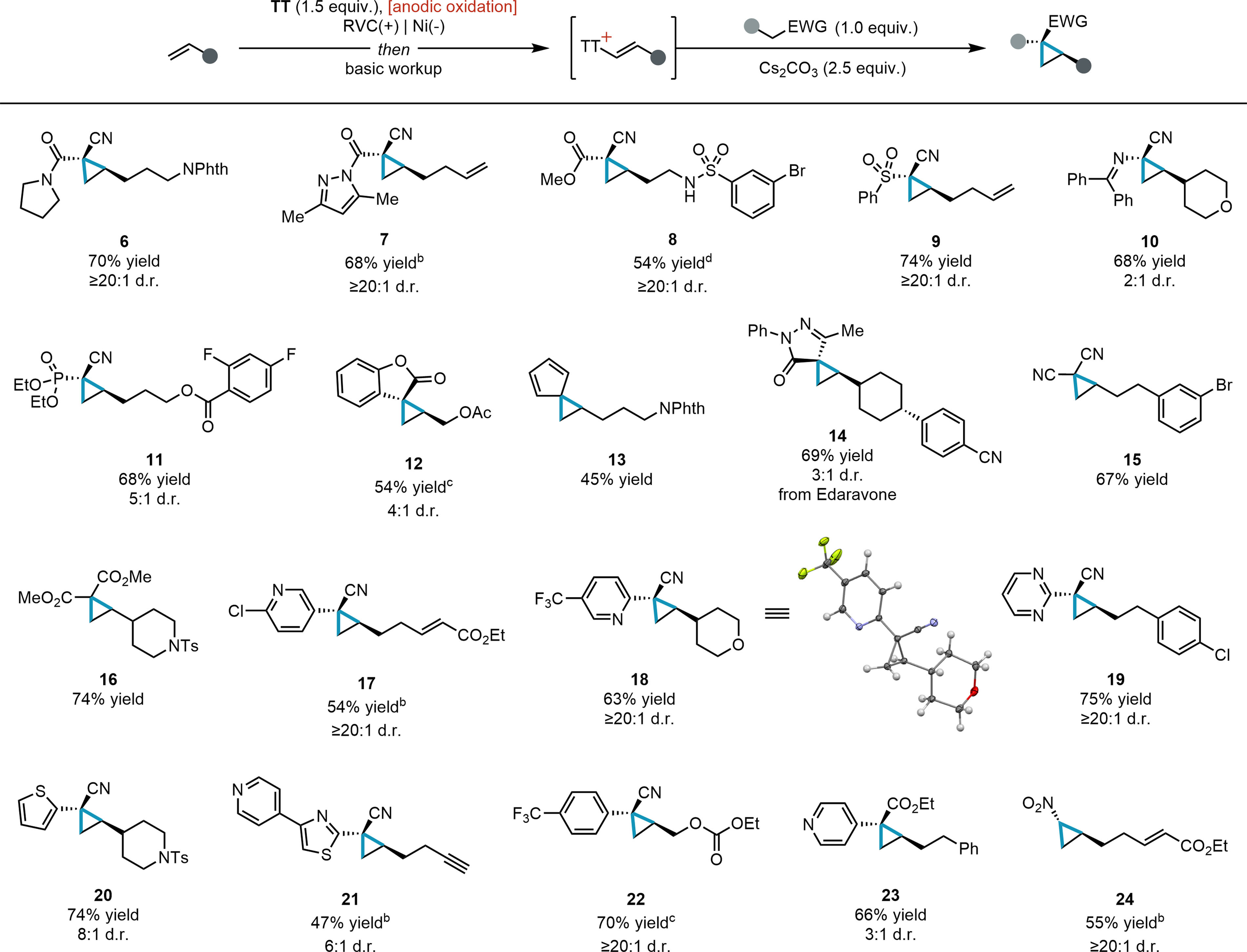
- [a] Reactions were conducted using alkene (0.4 mmol), TT (0.6 mmol), 8 mL of MeCN (0.2 M n-Bu4NPF6); then pronucleophile (0.4 mmol), Cs2CO3 (1.0 mmol), 2 h. Yields and d.r. are of the purified product as a racemate unless otherwise noted. See the Supporting Information for further details. [b] NMR yield. [c] Alkene (0.8 mmol), TT (1.2 mmol), 8 mL of MeCN (0.2 M n-Bu4NPF6). [d] Alkene (0.6 mmol), TT (0.9 mmol), 8 mL of MeCN (0.2 M n-Bu4NPF6).
We next evaluated the viability of performing this process on preparative scale (Scheme 2). We synthesized product 25 on multigram scale (3.3 g, 72 % yield, 7.9 mmol, ≥20 : 1 d.r.) using a 1 : 1 stoichiometry of the alkene and pronucleophile coupling partners. This representative example is illustrative of the power of this protocol in the synthesis of versatile cyclopropane building blocks. Specifically, compound 25 bears orthogonal handles for further functionalization using robust reactions, such as SNAr and Grignard addition. Of note, this practical batch electrolysis reaction setup is comprised of a DC power supply, inexpensive electrodes, and a divided cell and does not require any precautions to exclude air or moisture. Combined with the low cost102 low toxicity103 and recyclability67 of the thianthrene promoter, these results demonstrate the scalability of this electrochemical cyclopropanation protocol.
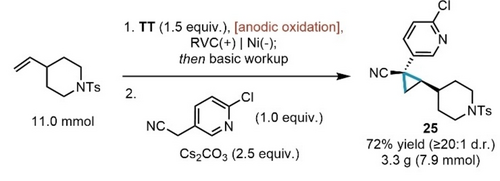
Preparative scale cyclopropanation.[a] [a] Reaction was conducted using alkene (11.0 mmol), TT (16.5 mmol), 110 mL of MeCN (0.2 M n-Bu4NPF6); then pronucleophile (11.0 mmol), Cs2CO3 (27.5 mmol), 16 h. Yield and d.r. are of the purified product.
We recognized that use of feedstock alkenes would enable access to cyclopropane building blocks from exceptionally inexpensive starting materials. Anodic oxidation of thianthrene under 1 atm of ethylene, propene, 1-butene, and 2-methyl-1-butene each delivered dicationic adducts that could be subsequently converted to the desired cyclopropane products (Table 2). When relevant, these reactions proceeded with high diastereoselectivity even in the case of propene (27, 29, 30), which bears a relatively small methyl substituent. These data illustrate how the high functional group tolerance of this method can be leveraged to prepare diverse cyclopropane building blocks for drug discovery from simple precursors.
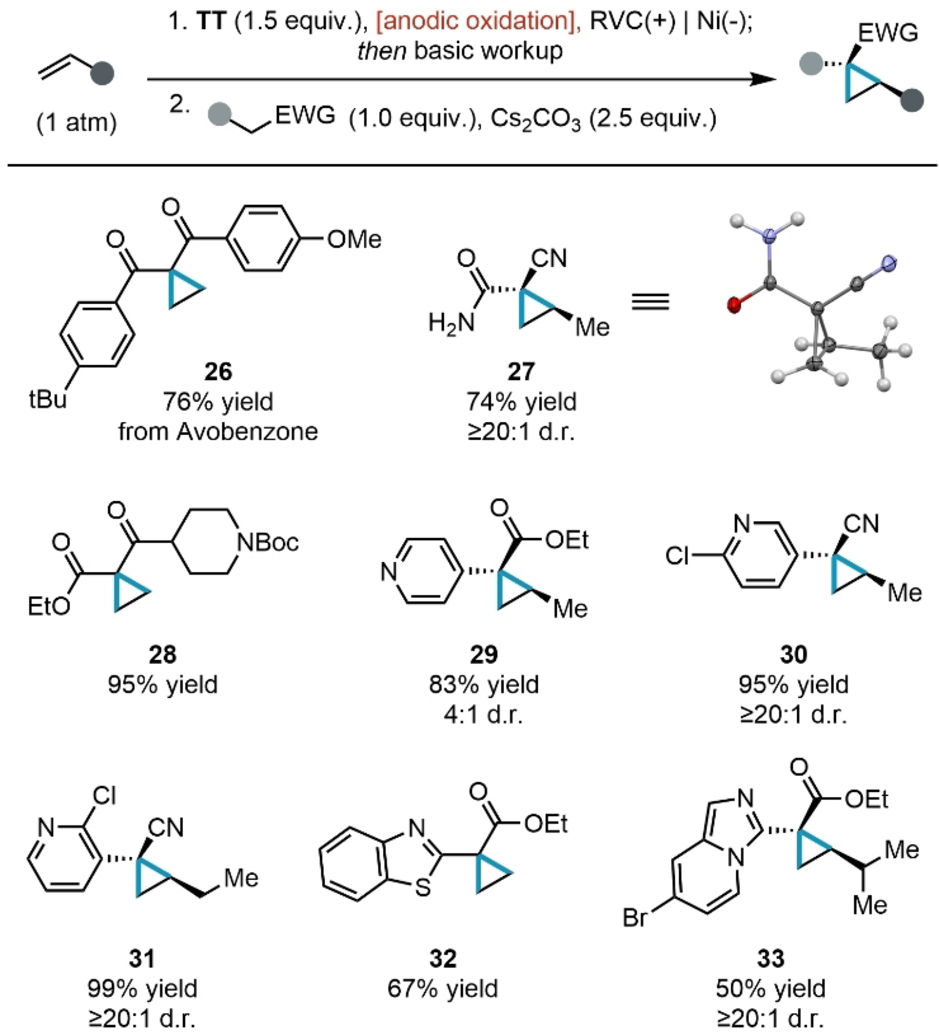
- [a] Reactions were conducted using alkene (1 atm), TT (1.0 mmol), 4 mL of MeCN (0.4 M n-Bu4NPF6); then pronucleophile (0.4 mmol), Cs2CO3 (1.0 mmol), 14–16 h. Yields and d.r. are of the purified product. See the Supporting Information for futher details.
We envisioned that this newly realized oxidative cyclopropanation methodology would have immediate utility through both the preparation of established cyclopropane targets as well as previously unknown derivatives. As an illustrative example, we prepared cyclopropane 34 from a commercially available benzylic nitrile and ethylene (1 atm) in high yield (Scheme 3). Compound 34 is an established intermediate in the synthesis of two distinct small molecule components in the most common cystic fibrosis drugs (lumacaftor and tezacaftor; total sales in 2021 amounted to $6.9 B USD).104 The established route to 34 constructs the cyclopropane ring through an enolate dialkylation using 1,2-dihaloethane.105, 106 While circumventing this carcinogenic dihalide may offer strategic advantages in synthesis of 34, we anticipated that the true power of this oxidative coupling route would lie in the synthesis of new structural analogs to this key intermediate. Indeed, no analogs of intermediate 34 bearing additional substituents on the cyclopropane moiety have been previously reported, presumably due to the limitations associated with substituted dihalide dielectrophiles. To this end, we prepared a series of substituted analogs of 34 by varying the alkene coupling partner (35–37). This approach enabled both large structural changes, such as replacement of a cyclopropyl hydrogen with a piperidine ring (35), as well as small perturbations, accessing methylated analog 37. Attempts to access the same products from analogous vicinal dihalide starting materials resulted in at most trace product. Taken together, these results illustrate how this new technology can impact the cyclopropane compounds prepared and studied in medicinal chemistry.
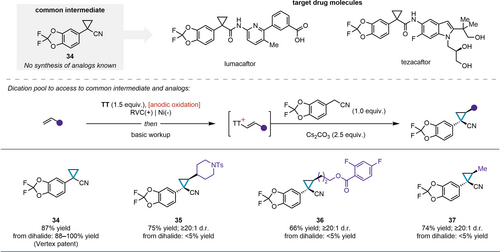
Synthesis of drug intermediate and analogs.[a] [a] Gaseous alkene reactions were conducted using alkene (1 atm), TT (1.0 mmol), 4 mL of MeCN (0.4 M n-Bu4NPF6); then pronucleophile (0.4 mmol), Cs2CO3 (1.0 mmol), 14–16 h. Reactions with non-gaseous alkenes were conducted using alkene (0.4 mmol), TT (0.6 mmol), 8 mL of MeCN (0.2 M n-Bu4NPF6); then pronucleophile (0.4 mmol), Cs2CO3 (1.0 mmol), 2 h. Yields and d.r. are of the purified product. See the Supporting Information for further details.
Overall, we have developed a modular procedure to prepare cyclopropanes from abundant carbon pronucleophiles and alkenes via electrochemically-generated thianthrenium salts. Mechanistic studies revealed that the dicationic adducts underwent rapid elimination under the reaction conditions to form an alkenyl thianthrenium salt, which serves as a key electrophilic intermediate en route to cyclopropanes. This approach is amenable to generation of diverse cyclopropanes bearing medicinally-relevant functional groups and handles for further elaboration. This cyclopropanation strategy allows for highly diastereoselective synthesis of nitrile-substituted cyclopropanes and furnishes complementary relative stereochemistry when compared to conventional metal-catalyzed approaches. This method expands the scope of readily accessible cyclopropane building blocks using inexpensive coupling partners and reagents. We anticipate that this new transformation will find broad application in organic synthesis given the growing interest in cyclopropanes in medicinal chemistry and beyond.
Acknowledgments
We thank the Stahl, Weix, Yoon, and Schomaker groups for sharing their chemical inventory. This work was financially supported by the Office of the Vice Chancellor for Research and Graduate Education at the University of Wisconsin, Madison, with funding from the Wisconsin Alumni Research Foundation. Spectroscopic instrumentation was supported by a generous gift from Paul J. and Margaret M. Bender, NSF (CHE-1048642), and NIH (S10OD012245 and 1S10OD020022-1). The Bruker D8 VENTURE Photon III X-ray diffractometer was partially funded by NSF Award #CHE-1919350 to the UW, Madison Department of Chemistry. This material is based upon work supported by the National Science Foundation Graduate Research Fellowship Program under grant no. DGE-1747503 (K.T.). Any opinions, findings, and conclusions or recommendations expressed in this material are those of the author(s) and do not necessarily reflect the views of the National Science Foundation. A.H. was supported by a Nicholas O'Connor Research Fellowship.
Conflict of interest
The authors declare no conflict of interest.
Open Research
Data Availability Statement
The data that support the findings of this study are available in the Supporting Information of this article.



